Breed Information
All breeds of horses have a history, whether it be ancient or modern and the Gypsy Horse is no different. He is known across the world by many different names. ie. Gypsy Horse, Gypsy Cob, Gypsy Vanner, Irish Cob and Tinker.
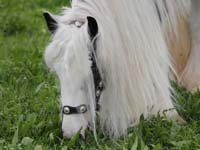 While some Gypsies prefer to call themselves "Travellers" and others "Romani" or "The Rom", here, with no disrespect meant, we will simply refer to them as "Gypsies". Remember those known as Irish Tavellers - sometimes also called Tinkers, and those known as Romanies, were two very different races and peoples and not related to each other in any way. In fact they were enemies for generations. While some Gypsies prefer to call themselves "Travellers" and others "Romani" or "The Rom", here, with no disrespect meant, we will simply refer to them as "Gypsies". Remember those known as Irish Tavellers - sometimes also called Tinkers, and those known as Romanies, were two very different races and peoples and not related to each other in any way. In fact they were enemies for generations.
The Gypsy Horse has been well known and bred by the Gypsies in England, Ireland, Wales and Scotland, for a hundred years and more. In recent years, he has also become widely known in European Countries, "outside" the Gypsy communities. The breed in the US can still be considered in it's infancy however.
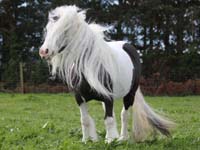 While most Gypsies could not read or write, some lines of the breed and their ancestry was well known and passed down through generations. Don't think for a moment, that because pedigrees were not written and recorded on paper, that some of what is known about the different lines, cannot somehow be correct. That said however, let's not at the same time, believe that everything we have been told, is true! While most Gypsies could not read or write, some lines of the breed and their ancestry was well known and passed down through generations. Don't think for a moment, that because pedigrees were not written and recorded on paper, that some of what is known about the different lines, cannot somehow be correct. That said however, let's not at the same time, believe that everything we have been told, is true!
But many Gypsies of generations ago, prided themselves on knowing the Ancestry of their horses, as much as those alive today. The knowledge and accuracy of the bloodlines and especially the "greats" of the breed, is a huge source of pride among them.
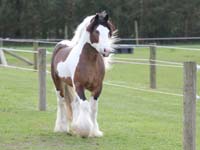 Early Gypsies soon discovered what was necessary in the horses they owned and used. In the very early days, Gypsies originally travelled using flat carts, on which they placed their tents and everything else they owned. At that time, the horses they used didn't have to be particularly large. They actually liked them to have a little pulling power, but much speed, so they could get around more quickly. Early Gypsies soon discovered what was necessary in the horses they owned and used. In the very early days, Gypsies originally travelled using flat carts, on which they placed their tents and everything else they owned. At that time, the horses they used didn't have to be particularly large. They actually liked them to have a little pulling power, but much speed, so they could get around more quickly.
Later, when the Gypsies turned to living wagons, they obviously needed heavier and stronger horses to pull the load. Those horses had to be strong enough to pull their caravans and caravans weighed an enormous amount. Just imagine the weight, not only of the caravan itself, but the fact that it carried everything the entire family owned. All clothing, pots and pans, dishes, linens and most even had pot belly and/or cooking stoves. Most caravans weighed so much, that everyone except the very young and elderly, walked beside them as they journeyed from one place to another. Often, the men walked just alongside to their next possible source of income or campsite for the night.
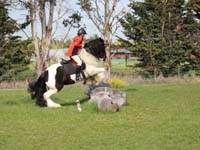 So to be able to pull all this, their horses had to have solid, weighty bodies, huge bone, thick necks and a great layback of shoulder. They had to have strong legs and large feet. They had to be unflappable in any situation and absolutely solid and reliable in their interaction with humans, including children. They had to be tough enough to exist in the harshest of weather and often on meagre food sources. They had to be able to pull a caravan all day if necessary covering sometimes 40 miles or more on hard roads or muddy lanes. They had to have a willing "work ethic" and always do what was required of them. In the past, most existed on what was found growing along country roads when the family camped for the night, so they had to be what we refer to today, as "easy keepers". So to be able to pull all this, their horses had to have solid, weighty bodies, huge bone, thick necks and a great layback of shoulder. They had to have strong legs and large feet. They had to be unflappable in any situation and absolutely solid and reliable in their interaction with humans, including children. They had to be tough enough to exist in the harshest of weather and often on meagre food sources. They had to be able to pull a caravan all day if necessary covering sometimes 40 miles or more on hard roads or muddy lanes. They had to have a willing "work ethic" and always do what was required of them. In the past, most existed on what was found growing along country roads when the family camped for the night, so they had to be what we refer to today, as "easy keepers".
When the Gypsies moved into heavy living wagons, to meet their requirements of a horse with great pulling power, it is without doubt that there was then, a great introduction of Shire, Clydesdale and other heavy horses, which went to make the horse the Gypsies desired and needed. He changed from a light weight horse who previously had only needed to pull flat carts, to a much larger Draft type horse.
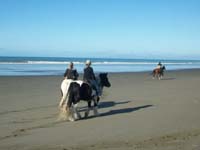 While in early days, all colours were prized if the horse itself was good, as time went on, the Gypsies began to favour more, the coloured horses of Black and White or Bay and White. However, the breed can be found in all colours. While in early days, all colours were prized if the horse itself was good, as time went on, the Gypsies began to favour more, the coloured horses of Black and White or Bay and White. However, the breed can be found in all colours.
Years ago, Gypsies did not breed for feather. Many of their horses had it, due to their background, but the Gypsies never bred for it. Heavy Feather was too much of a problem for them and gathered too much mud since much of the time, they travelled on unpaved, muddy roads and lanes. It is only in more recent times, maybe 50 years or so, where heavy feather has been known and desired more in the breed.
Some of the great horses who in turn produced great offspring, were remembered by the Gypsies, generation after generation, even until today. Their Ancestry was known throughout all the Gypsy communities. Certain great Stallions were used on their best Mares and also on Mares owned by Gypsies in other communities. And so, as time went on, the Breed developed into the horse we know today, as the Gypsy Horse.
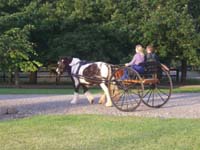 The Gypsies bred other types of horses – some to be tremendous trotters, since trotting races have been a long passion of the travelling peoples. They also knew their various "types" of horses, by different names. But the horse we know as the Gypsy Horse today, had his beginnings as purely a horse, able to pull quite heavy loads. The Gypsies bred other types of horses – some to be tremendous trotters, since trotting races have been a long passion of the travelling peoples. They also knew their various "types" of horses, by different names. But the horse we know as the Gypsy Horse today, had his beginnings as purely a horse, able to pull quite heavy loads.
Not that the Gypsy Horse today, is not known for many other disciplines. He is an extremely able jumper, a Dressage horse, and a Western and English Pleasure mount. Some have even excelled as Cutting horses. And yes, many still find him the ideal driving horse, with flash and power to spare.
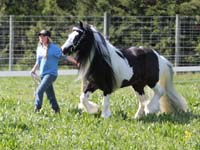 He is an all round, fun horse for young and old alike. Perfect for youngsters, since his temperament lends easily, for children. Older people like him for his often smaller size. The older people become, the less they wish to climb aboard a too tall a horse. He is an all round, fun horse for young and old alike. Perfect for youngsters, since his temperament lends easily, for children. Older people like him for his often smaller size. The older people become, the less they wish to climb aboard a too tall a horse.
Lucky indeed are we today, who can say we own a truly unique Breed of Horse, who's Ancestry and History is not lost in time, but treasured greatly by those who know him. A great debt of gratitude is owed to those men of old, who maybe made the "perfect" horse.
|
Join Us on ......
 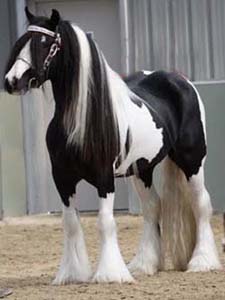
We believe in breeding the best to the best. Our superb stallions are bred only to our personal mares to produce superior Gypsy Horses.
Click Here >>
Recently we have started a breeding program with Orana Park.
Click Here >>
|



